The guide that comes with the Kaikoura Coast Track says it all: Follow our signs, take time to rest, and admire the views.
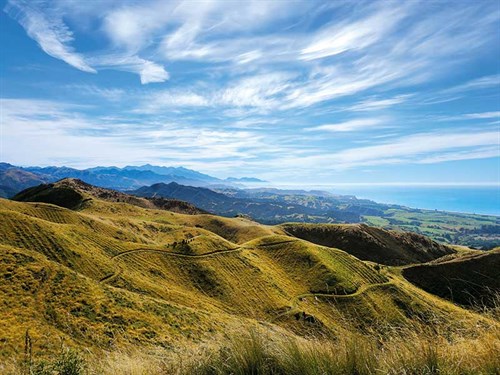
We followed, rested, and oh, how we admired those views. Jeanette (my travelling companion) and I did our usual preparation for a two-day walking adventure across farmland: nothing.
We didn’t suffer overly, although some work on the legs might have helped.
The track begins at Conway Flat (about 40km south of Kaikoura) and takes you through native bush seeded with ripe blackberries, cool streams, final slogs to hilltops, and the best tea you’ll ever drink.
The coastal track's founders
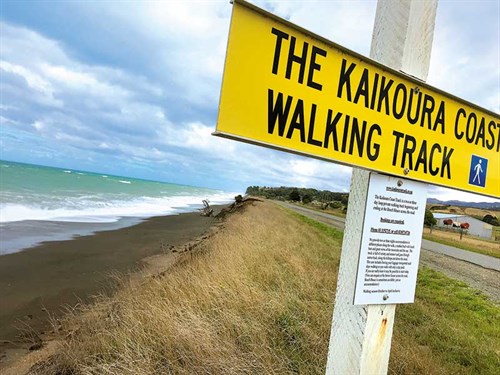
The Kaikoura Coast Track was established by Sally and David Handyside and Bruce and Heather Macfarlane, who added the two-day 26km-walk to their beef and sheep farming activities in 1994 in order to share their piece of paradise with others.
Their weekend getaway package includes accommodation with catering as an optional extra.
We booked months before the Kaikoura earthquake, but despite it shaking up much of the area, the walk was undamaged. We opted for Sally and Heather’s wonderful catering with its generous portions, including an extra lamb shank for Pedro, our tour guide on day two.
Day one: Up to Medina homestead
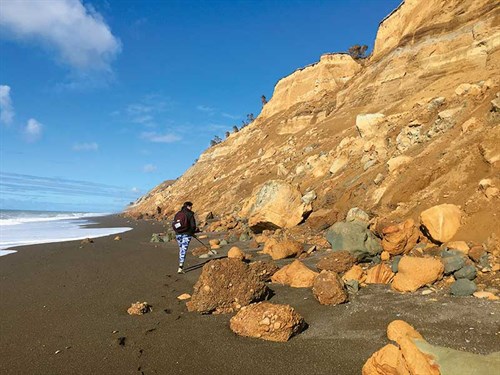
The first day takes you along the coast and up to the Medina homestead. The quake had pushed the beach up on a steeper angle, with soft sand making it hard going.
In places, crumbling cliffs have reduced the beach to half its width, with the occasional massive tree flung back from the seas. The cliffs tell the story of 14,000 years of history in their layers, so take the time to look.
“Keep an eye out for dolphins and seals,” Sally said. “Particularly as you approach Seal Gap.”
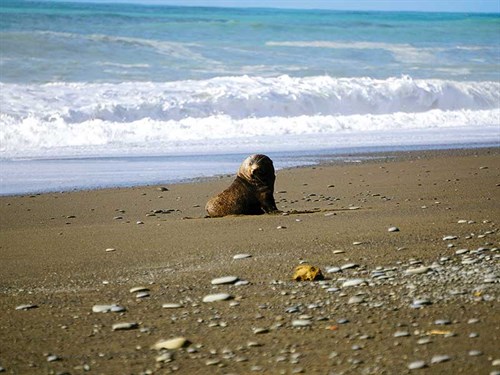
No dolphins and one lone seal on the beach, but we were delighted by its appearance. We turned off the beach to Circle Hut and enjoyed the best tea we’d had in a long time. Alas, no boiling the billy over an open flame due to the fire risk.
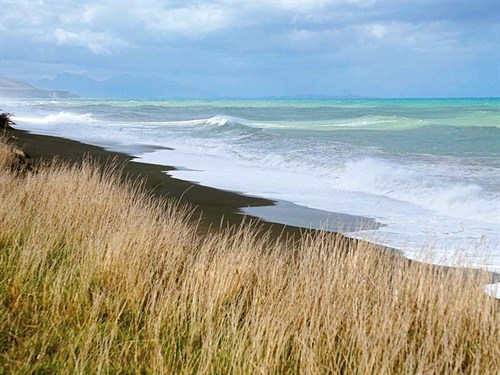
This is where the climbing began, but from the lookout on the top, there are stunning views of Kaikoura Peninsula to the north and Banks Peninsula to the south. This is big sky territory; so again, take your time to look.
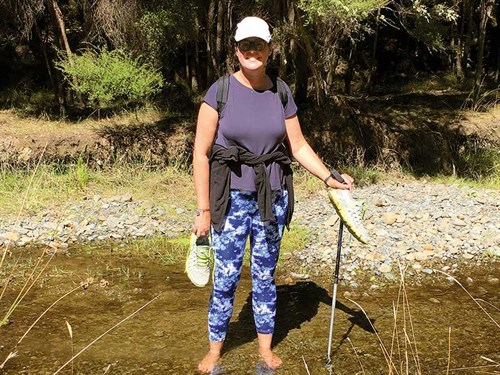
Back down again, this time into bush with ancient matai and kahikatea, an icy-cold stream that was so good on over-heated feet, and shady glens to sit, drink water, and listen to the birds.
Next, we headed up through the gully to farmland and grabbed a photo opportunity at ‘Rest and Reflect’ sign at the top, now in blazing sunshine with green pasture and blue ocean beyond.
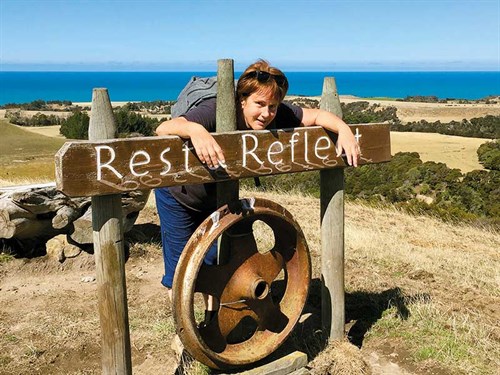
Soon after, we reached the Medina homestead hot, sweaty, and desperate for something ice-cold.
Sally had anticipated this and had pitchers of homemade lemonade waiting in the fridge. We peeled off our shoes and socks, retired to chairs outside, and drank it all.
Sally arrived with dinner, dessert, breakfast, and Pedro—the leggy black house dog—who would be joining us the next day (and knew the way, so we couldn’t possibly get lost).
Day two: Skull Peak Hut and down again
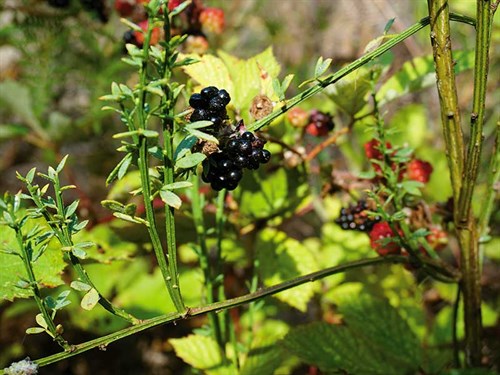
Day two saw us take a short ride to Buntings Gully—the start of the climb to Skull Peak day hut.
At 9am, the hillside was not quite in the sun, so it was cool and damp, and the blackberries were delicious. Pedro enjoyed leaping into the bush either side of the track, waiting ahead until we caught up.
The guide says it takes around three hours to read the skyline through ancient beech forest, native trees, and ferns. Pedro raced around, covering twice the distance we did, and I topped him up with lamb shank meat and water.
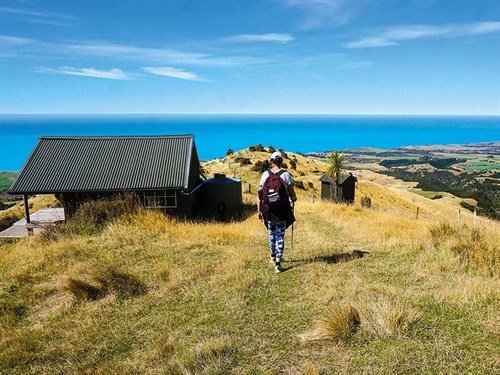
At the top, we bypassed the last leg to the very top of Skull Peak, agreeing we’d done very well but needed a break from the heat. Pedro agreed and we flopped into the shelter.
Again, everything you need for tea or coffee, and this time, a most welcome toilet. We sat speechless, taking in the view north and south, across the farmland and out to the blue sea.
From here, you still have a way to go, but it’s mostly downhill across paddocks and stiles where Pedro waited, often with his eyes suggesting we were taking too long.
Our last stand of native bush—Mamaku Reserve—was good shelter from the early afternoon sun. We were nearly there, but there was one last hill, which was so cruel given we thought we’d reached the road.
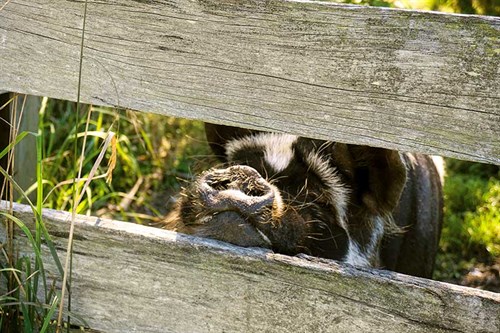
When we did hit the road, Pedro, with just a hint of criticism at our slow progress, set off down to the coast road at a steady trot. Jeanette fed her apple to a horse and I gave mine to a large pig, who ate it with gusto and much dribbling.
Down on the coast road, Pedro was getting into a red station wagon. “The turncoat,” we thought. “He’s not even going to walk the full distance.” Beside the car, Bruce Macfarlane had come to collect Pedro, who was ready for dinner and a sleep.
Back at the cottage where we started, new walkers had arrived: a couple and a group of Canterbury women with a good supply of wine.
Heather arrived with fresh farm eggs as a gift and we headed for Springfield where our hostess had thoughtfully put bacon in the fridge.
“Not bad,” Jeanette said. And we started talking about the next walk and how we’d prepare properly. Yeah, right.
What you need to know for the Kiakoura's coastal track
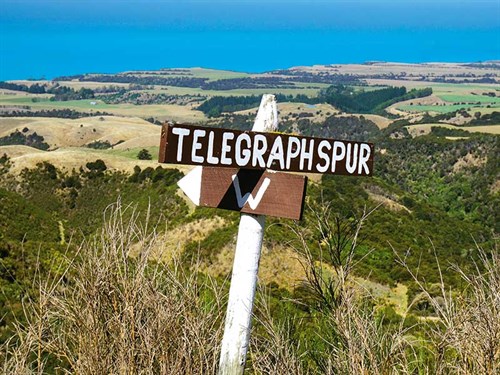
- If you’re coming from the north, check the roads first
- Day one is 12km and day two is 12.3km
- Walking poles are a good idea
- Take a thank-you treat for Pedro
- You need waterproof walking boots because they will get wet in the stream crossings unless you have the agility of a gazelle
Find out more at kaikouratrack.co.nz





